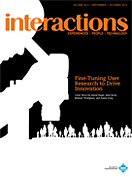Table of Contents
VOLUME XX.5 September + October 2013
-
Demo Hour
-
Demo hour
Javier Quevedo-Fernández, J. Martens, John Hansen, Wang Wusheng, Irina Shklovski, Jari Varsaluoma, Ville Kentta, Alexandre Alapetite, John Hansen, I. MacKenzie
idAnimate idAnimate is a general-purpose animation sketching tool for multitouch interfaces, in particular for the iPad. idAnimate allows its users to create meaningful and expressive animations within minutes or seconds. Animations are created by simply moving, scaling, and rotating the objects on the screen with the tips of the…
-
-
Confessions
-
Dive into the sea of inspiration
Tek-Jin Nam

It was 26 years ago that I first dipped my toes into the waters of industrial design and began to understand how professionals make a living doing it. I was a university freshman and took a special introductory seminar that set me on course for my still ongoing academic…
-
-
Feedback
-
Feedback

Blog: The UX ownership war is over ... and we have lost! (by Daniel Rosenberg; http://interactions.acm.org/blog/view/the-ux-ownership-war-is-over-and-we-have-lost) Despite the truth of what you say and my own experiences, I'm not so sure the episode you recount indicates the final battle in the war. On the contrary, I would say it…
-
-
Departments
-
HCI in the outside world
Gerrit van der Veer

The readers of interactions know what HCI stands for. That is why we subscribe to the magazine or join SIGCHI. Even though we come from a diversity of disciplines and consider ourselves practitioners, academics, students, or "just users," we agree on the importance of this young field, on the…
-
Community Calendar 2013
CACM Staff

September 2013 DPPI 2013 6th International Conference on Designing Pleasurable Products and Interfaces (Newcastle, UK) Conference Dates: September 35, 2013 http://www.praxisandpoetics.org/dppi/ UbiComp 2013 2013 ACM International Joint Conference on Pervasive and Ubiquitous Computing (Zurich, Switzerland) Conference Dates: September 812, 2013 http://www.ubicomp.org/ubicomp2013/ ISWC 2013 17th International Symposium…
-
-
Columns
-
Putting the person back into personalization
Elizabeth Churchill

Personalization. It's one of the words of our times. I heard it five times yesterday in different conversations. I think I also uttered it once or twice, pushing the count up further. As I reflected on the conversations of the day, it became clear there are many different denotations…
-
Demo or die?
Jonathan Bean, Daniela Rosner

A tall, blond woman walks expressionless through the apartment, her stiletto boots registering nary a click on the floors. The apartment is small, 325 square feet to be exact, or about the size of a two-car garage. It is impeccably furnished, electric colors popping up against a slick ground…
-
-
Day in the Lab
-
Interaction lab, Holon Institute of Technology
Michal Rinott

How do you describe your lab to visitors? I describe the lab as a space for designing interactions. We explore the meeting point between people, design, and technology, creating prototypes that propose new interactive experiences and new qualities of interactions. We are interested in both the product and the…
-
-
Forums
-
Interaction design, heritage, and the self
Jayne Wallace

Heritage is perhaps most commonly couched in terms of things that are left to us (inheritance) or things we leave to others (legacy). But it is also part of a patchwork by which we define ourselves. Implicit in the notion of heritage is a richness of some kindtraditions earned,…
-
Listening in the moment
Patti Brennan, Wendy Swanberg

Right now, there is terrific momentum and energy around the idea of digital health technology. Earlier this year a writer for Forbes magazine called 2013 "The Year of Digital Health" [1]. At the 2013 Consumer Electronics Show, health-related devices accounted for nearly one-quarter of the items on displayeverything from…
-
Public policy and the global public inclusive infrastructure project
Clayton Lewis, Jutta Treviranus

The Global Public Inclusive Infrastructure (GPII) project is an international collaboration to make information technology, and the content and services it delivers, easily accessible to everyone, including people with disabilities. What role does public policy have in promoting this aim? How can ACM members around the world help shape…
-
The first killer app
Melissa Zynda

The CHI literature includes few studies of applications such as spreadsheets and databases that are used more in business than by consumers and researchers. However, the spreadsheet inspired many early proponents of user-centered design. Melissa Rodriguez Zynda recounts its emergence and evolution.Jonathan Grudin If we said that the history…
-
Making instructions for others
Robert Phillips, Dan Lockton, Sharon Baurley, Sarah Silve

Investigating how people understand the systems around themfrom technology to democracy to our own bodiesis a common research goal across many disciplines. One of the practical aims is uncovering differences between how people think systems work and how they actually work (particularly where differences can cause problems) and then…
-
Pressing exit
Eli Blevis

Image Contributor: Eli Blevis Genre: Found interactivity ©2013 ACM1072-5220/13/09$15.00 Permission to make digital or hard copies of all or part of this work for personal or classroom use is granted without fee provided that copies are not made or distributed for profit or commercial advantage and that copies…
-
-
Features
-
Web 3.0 has begun
Neal Cabage, Sonya Zhang

A lot has changed since the release of Apple's first iPhone in 2007. We have witnessed a profound shift in user behavior, away from desktop computers in favor of new form-factor devices. The enabling technology has also brought about an entirely new class of Web-enabled applications and architectural ideals.…
-
The magical features of immersive audiovisual environments
Rodrigo Carvalho

For centuries, artists, scientists, writers, designers, engineers, and others have explored audiovisual environments to create augmented realities and temporary autonomous spaces. The constant evolution of new media technologies provides the creators with better tools each day, allowing them to merge existing physical spaces with the virtualthe digital and imaginary…
-
‘Let me finish’
Charles Hannon

Almost 20 years ago in Being Digital, Nicholas Negroponte imagined the ideal computer interface as a digital butler, a machine that would anticipate and provide for our needs before we were even conscious of them [1]. In his vision, our digital butler would take the smallest piece of informationthe…
-
30 years at the University of Maryland’s human-computer interaction lab (HCIL)
Ben Shneiderman, Kent Norman, Catherine Plaisant, Benjamin Bederson, Allison Druin, Jennifer Golbeck

Founded in 1983, the Human-Computer Interaction Lab (HCIL; www.cs.umd.edu/hcil) has followed the arc of human-computer interaction from its inception to its current influential role in computing. At a time when emergent personal computers and office technologies were broadening the base of who used computers, it seemed essential to address…
-
Words with friends
Tom Boellstorff, Bonnie Nardi, Celia Pearce, T. Taylor

In this article we detail primarily online collaborative authoring practices we have found to be of practical and conceptual interest. In 2012, the four of us published Ethnography and Virtual Worlds: A Handbook of Method [1]. Prior to composing this text, all of us had written book-length ethnographies of…
-
-
Cover story
-
Fine-tuning user research to drive innovation
David Siegel, Alex Sorin, Michael Thompson, Susan Dray

User research that attempts to discover market-changing innovations faces many challenges. The more ambitious the innovation goal, the more difficult it can be to decide whom to study, what to look for, and how to make sense of the findings. Our reflections here are based on our experience collaborating…
-



